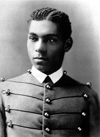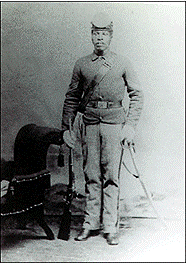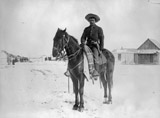|
|
|
|
Pages best viewed with IExplorer.
Size of text in "View", can affect page display.
www.buffalosoldier.net supports a "Kid Safe" Internet.
Part 1
Personal Profile
As a Buffalo Soldier, great-grandfather, Sergeant Henry Parker, and the U.S. army were a part of the Plains Indian's
nightmare. As an American soldier, he served his country under the worst of conditions, showing the courage and bravery
that has been the tradition of all fighting men, no matter their cause, no matter their sacrifice. It should
be noted, that Regimental returns show that the Buffalo Soldiers were not involved in Indian massacres, though
they were camped near the sites of two incidents and assisted those who survived. It is this author's stated belief, that the Buffalo Soldiers did not mistreat Native-Americans and were not responsible for their removal from reservations.
After escaping from his slavemaster in Apton Valley, Kentucky, great-grandfather joined the 101st Regiment United
States Colored Infantry, at 18 years of age. He served three years as a private in the Civil War. Action was seen
at White's Ranch, Boyd's Station and Stevenson's Gap, and at Scottsborough and Larkinsville, Alabama.
Henry Parker enlisted in the U.S. Cavalry on May 18, 1867 in Memphis, Tennessee by Captain Davis for a period of
five years. He was 21 years old and listed his occupation as a groom. His description included black eyes, black
hair and a complexion listed as mulatto. Henry's height was recorded as 5'9 1/2". He was assigned to Company
D of the Tenth U.S. Cavalry and was discharged on May 18, 1872 at Ft. Sill, Indian Territory * as a private. Fort Sill ca. 1827-1876,
courtesy
of the National Archives, Fort Sill today. Remarkably, he never reported
for sick call during the first two years and four months of service.
On June 6, 1872, Henry Parker re-en1isted in the army at Fort Sill for another five years. His height, however,
was now listed as 5' 11 1/2". He was again assigned to Company D of the Tenth U.S. Cavalry. When discharged
at Fort Concho, Texas on June 6, 1877, Henry Parker was a sergeant, a member of the "Color
Guard" with his character listed as "Excellent".
Introduction
In every major war, throughout the history of the United States, from the American Revolution through the Indian
Wars, Native-Americans and African-Americans have fought with and against each other. This scenario prevailed
during the Civil War. Some tribes fought for the South, such as the Cherokees while others assisted the North
like the Seminoles.
Slaves and the black soldiers, who couldn't read or write, had no idea of the historical deprivations and
the frequent genocidal intent of the U.S. government toward Native Americans. Free blacks, whether they could
read and write, generally had no access to first hand or second-hand unbiased information on this relationship.
Most whites who had access often didn't really care about the situation. It was business as usual in the name of
"Manifest Destiny". Most Americans viewed the Indians as incorrigible and non-reformable savages. Those
closest to the warring factions or who were threaten by it, naturally wanted government protection at any cost.
At the outbreak of the Civil War, the government was fighting the Indians in the west. It withdrew most of its
men and resources from the Indian wars, to concentrate on ending the rebellion. At the end of the Civil War, 186,000
black soldiers had participated in the war, with 38,000 killed in action. Southerners and eastern populations did
not want to see armed Negro soldiers near or in their communities. They were also afraid of the labor market being
flooded with a new source of labor. General employment opportunities in these communities was not available to
blacks, so many African-Americans took a long hard look at military service which offered shelter, education, steady
pay, medical attention and a pension. Some decided it was much better than frequent civilian unemployment. Of course
in some quarters, it was thought this is an good way of getting rid of two problems at the same time.
When Congress reorganized the peacetime regular army in the summer of 1866, it had taken the above situation into
account. It also recognized the military merits of black soldiers by authorizing two segregated regiments of black
cavalry, the Ninth United States Cavalry and the Tenth United States Cavalry and the 24th, 25th , 38th , 39th,
40th and 41st Infantry Regiments. Orders were given to transfer the troops to the western war arena, where
they would join the army's fight with the Indians. In 1869, one year after the discharge of Cathay Williams, the female Buffalo Soldier in disguise,
the black infantry regiments were consolidated into two units, the Twenty-fourth United States Infantry and the
Twenty-fifth United States Infantry. All of the black regiments were commanded by white officers at that time. See
Captain David
Schooley 25th Infantry, Buffalo Soldiers.
|
|
Initial recruiting efforts concentrated on filling recruitment quotas with little
regard for the recruit's capability and soldiering skills. These recruits had to be discharged and replaced,
causing a delay in some regiments arriving at their assigned posts. Over a period of time, since whites could get
good jobs in peacetime and even highly educated blacks usually could not, recruiters increasingly, began to enlist
blacks who were more intelligent and capable than the average white soldier. This helped the eventual success and
acceptance of the first African-American graduate from West Point Military Academy who was also the first African-American
officer, posted to the Tenth U.S. Cavalry, Henry O. Flipper. Colonel Allen Allensworth was the first
African-American chaplain posted to the Twenty-fourth Infantry. He is also founder of the first black established
town just outside Bakersfield,
California. In the late 1880's West Point graduates
John H. Alexander and Charles Young were granted commissions
to the Ninth U.S. Cavalry. Reverend Theophilus Steward of the 25th Infantry, was also relentless in his efforts
to help his men in the areas of education, finances, moral and coping strategies as soldiers and as civilians.

Henry O.
Flipper. U.
S. Armylink
Photos
Black soldiers who fought in the Indian Wars, fought their opponents as they have done throughout this country's
military history. They fought to win and to give their lives if necessary, for their personal beliefs. They wanted
to gain the respect and equality they never saw as slaves and rarely received as freedmen. So, they continued on as soldiers. They were sadly mistaken in thinking they would gain
these components of freedom, in a country built in-part by their enslavement and which still held deep racial and
cultural prejudices.
As soon as these soldiers were relocated into their hostile environments, they were engaged in life and death struggles.
They were under fire. Friends were killed and their oath to keep the peace, put to the test by Indians, settlers
and those outside the law. Though they guarded railroads and telegraph lines, stagecoaches, arms shipments, towns,
homesteads, whites and Indians, they never knew when they would be ambushed by foes or the very townspeople they
were protecting! Not infrequently, just by entering a town or saloon, shoot-outs occurred. There was also the occasional
sniper, waiting for a kill. Those that murdered troopers were never punished for their crimes, even when there
were witnesses. The troopers always responded with a deadly intent of their own. When investigated by the military,
those troopers found guilty were punished accordingly, but not always justly.

Col. Allen Allensworth, Smithsonian Institute
After arriving at their posts the alternatives to soldiering were: desert
to all white communities, where they were regarded with hateful scorn and risk imprisonment. Death and torture
at the hands of the Indians or possible death by exposure to the killing heat and freezing cold. Though the Buffalo
Soldiers did their duty in carrying out the government's version of law and order on the frontier west, many influential
blacks such as Senator Blanche Kelso Bruce, continually spoke out for the Indians and against the United States
treaty making and treaty breaking policies.
Segregation in the Military
The army supported segregation. It maintained separate facilities where possible.
The Buffalo Soldiers built many forts whose facilities at times they couldn't use. At Fort Concho for example,
there were separate rooms for educational purposes, etc. The necessities of military life forced white and black
troops together, breaking down long standing prejudices. Lieutenant Charles J. Crane always believed in the superiority
of the Anglo-Saxon and resented his appoint to the Twenty-third Infantry. But in his autobiography he wrote he
was happy with the assignment.
So brave and courageous were these men that their legendary Indian foes called them Buffalo Soldiers. Their commanding
officer, Colonel Benjamin H. Grierson of Civil War fame, said the name was given because the Indians respected
a brave and powerful adversary, which relates directly to their much revered buffalo. Others say it was due
to the similarity of the soldier's hair to that of the hair surrounding the buffalo's head.
Desertion
The Tenth had the lowest desertion rate in the army, though their army posts were often in the worst country in the west. Official reports, show these soldiers were frequently subjected to the harshest of discipline, racist officers, and poor food, equipment and shelter. White regiments were supplied with silk-embroidered banners. The Tenth's regimental standard had to be homemade and was tattered and worn. The government did not send them a regulation flag until many, many years later. In spite of these deprivations, the morale of these soldiers remained high. Some white commanding officers were proud to lead these men and publicly expressed their feelings. In the end 20 black soldiers of the Ninth and Tenth Companies won the Medal of Honor, the highest award this country gives for the most outstanding performance under enemy fire.
There were hundreds of untold provocations toward the Indians by the settlers, the U.S and Mexican governments, outlaws, officials, the railroads and the list goes on and on. During the winter months, the Indian's response to these injustices decreased, giving the army and settlers some predictable relief. But placing the Indians on reservations without guns and ammunition and cutting their food rations to subsistence levels combined to force the Indians to go on raiding parties. Soon, along with starvation, came the ravages of the white man's diseases.
The name Staked Plains refers to the fact that early settlers had to drive stakes into the ground, to mark their trail. There were no distinguishing features on the plains, just miles and miles of flat, treeless land. Markers made it easier to retrace a route and for future settlers to follow. The scarcity of trees, necessitated the initial building of sod homes.
*Camp at Medicine Bluff Creek, Camp Wichita all refer to Fort Sill. The site
was first called Camp at Medicine Bluff Creek, then it was called Camp Wichita and finally in July of 1860, it
was designated Fort Sill. The post is still operational.
10th Cavalry Regimental Movements 1867-1880
(9th Cavalry, 24th & 25th Infantry Highlights)
The Plains Indians first accepted the arrival of the Five Civilized Nations as the government moved them onto the plains. However, as starvation and death move upon the reservations, the Plains Indians began to resent these tribes. The Five Civilized Nations had accepted the Plains Indian's land and were receiving adequate government food supplies, while the Plains Indians were hungry. Resentment to the Five Civilized Nations also occurred due to their adoption of the white man's ways such as farming, style of dress, home building and to some degree, slavery for life, based on a person's color and blood line.
May 1866:Fort Leavenworth; During each month, for the first ten months of its organization, at least one Buffalo Soldier died due to disease ( mainly cholera) and deadly dietary deficiencies. Twenty-three soldiers were lost during the Company's last month at the fort.
Summer of 1867-January 1868: Company
was stationed at Fort Arbuckle, Indian Territory. The Tenth U.S. Cavalry Troop D was posted along the Kansas Pacific
Railroad. Additional assignments included the building and rebuilding of Forts Arbuckle, Ft. Sill, Ft. Clark
and Fort Concho. Other tasks were stopping cattle rusting, bootleggers and the protection of settlers, Indians
and the mail.
Background Event: The
U.S. government decides to give up the treaty-breaking establishment of The Bozeman Trail.
Instead, they choose to follow the new route of the Union Pacific Railroad along the Platte River. The Sioux were
ordered to leave their home in the Platte Valley for a new reservation in South Dakota. The railroads were used
to break the Indians control of large tracts of land. At various times unsuspecting settlers bought land from the
railroads, at inflated prices, not knowing the land was already occupied.

Buffalo
Soldier, 25th
Infantryman
Smithsonian
Institute
August 1867: Fort Arbuckle, Kansas; Indians killed seven Union Pacific Railroad workers. Company F, while trailing them, was attacked by about two hundred warriors. After two hours of fighting, two hundred more warriors joined the conflict. The fight lasted six hours more with many hostiles killed. Two Buffalo Soldiers were killed, they were Sergeant Christe and Captain Armes. Six horses were also wounded.
September 19, 1867: Sergeant Davis and Troop G of the Ninth U.S. Cavalry, 45 miles west of Fort Hayes, engaged, but was soon surrounded by Indians. Running low on ammunition, Sergeant Davis and his men broke out of their deadly position and drove the Indians off. Private Randall and two citizens are wounded. Two other settlers had been killed prior to the attack.
Background Event: Bill Cody, working for the Kansas Pacific Railroad, kills 4,000 buffalo in an eight month period. He became famous as "Buffalo Bill Cody".
October, 1867-March 1868, Medicine Lodge Creek, Indian Territory: Though the Treaty Of Medicine Lodge was signed by the Southern Cheyennes, Arapahoes,
Comanches, Kiowa-Apaches and the Kiowa tribes, a few bands of Kiowa and Comanches continued to plague both the
settlers and other tribes. This period was considered relatively calm.
Background Event:Brevet Major General George Armstrong Custer, Lieutenant Colonel, 7th U.S. Cavalry, is court-martialed.

An Afro-American
Corporal, in the 9th
Cavalry. Snow
covers the ground
1890. Denver
Public Library.
February 1868: Cottonwood Grove, Indian Territory: Company in the field pursuing hostile Kiowa and Comanches. No contact was made. Tenth dispatched to the Eureka Valley Agency in response to raids in the area again, no contact with hostiles occurred.
Background Event: The Treaty of Bosque Redondo is signed with the leading Chiefs of the Navajo Nation including Chief Barboncito, thus ending the Navajo-Apache Wars.
March-May 1868: Company back at Fort Arbuckle, I. T. Wichita Agency is looted and burned by a Comanche war party. News of the attack was received too late, to effectively apprehend the war party.
Background Event: Lieutenant-Colonel George Armstrong Custer's first encounter with Indians results in the killing of Chief Black Kettle and his wife. Close to 100 more women, children and elders were also killed. Custer actively campaigned to stop African-Americans from getting the vote. When he was given a commission with the Buffalo Soldiers of the Ninth U.S. Cavalry, he refused to accept it. (To their good fortune). He was not the only officer to refuse a commission. Ironically, these very same Buffalo Soldiers ended up rescuing Custer and his command when he and his men were pinned down during an engagement.
June 1868: Camp Comanche, Indian Territory (Wichita Mountains);Colonel Grierson of Civil War fame, was ordered by the new commanding General of the Department of the Missouri, General Philip Sheridan, to move his headquarters to Fort Gibson and find a suitable location for a new fort within the Kiowa and Comanche reservation. After locating such a spot (Camp at Medicine Bluff Creek ), Grierson negotiated the release of six captives held by a band of Comanches near Otter Creek.
 |
|
 |
Background Event: Chief Red Cloud of the Oglala Sioux signs Fort Laramie Treaty of 1868 after winning a war against the U.S. and dictating the terms of the peace. He would not sign the treaty until the soldiers were gone and his Sioux burned the forts. |
| You may FREELY link to this Web site and its PERSONAL LINKS*, for NON-COMMERCIAL or PERSONAL USE ONLY. Copyright restrictions apply to the use, transmission and reproduction of images and content on this Web site, Web page, and its links. Any other use, without prior written permission of the copyright owners is prohibited. Buffalosoldier.net is not responsible for any losses due to linking to its Web pages and links. |
Send e-mail to: sldavis@inreach.com
Copyright 1999 Stanford L. Davis, M.A.
All Rights Reserved
www.buffalosoldier.net